|
| Conic
Sections |
|
|
|
|
Parabola
|
 Definition and construction
of the parabola
Definition and construction
of the parabola
|
|
Construction of the parabola
|
 Vertex form of the equation of a parabola
Vertex form of the equation of a parabola
|
 Transformation of the equation of a parabola
Transformation of the equation of a parabola
|
 Graphs of the parabola examples
Graphs of the parabola examples
|
|
|
|
|
|
|
| Definition and construction
of the parabola
|
| A parabola is the set of all points in a plane that are the same distance from a point F, called the focus, and a
line d, called the
directrix. |
|
A parabola is uniquely determined by the distance of
the focus from the directrix.
|
|
This distance is called the
focal parameter
p
and its
midpoint A is the vertex
(apex) of the parabola.
|
| The parabola has an axis of symmetry which passes
through the
focus perpendicular to the directrix.
|
|
The distance of any point
P
of the parabola from the
directrix and from the focus is denoted r, so
|
|
d(Pd
P) =
FP =
r.
|
|
Construction of the parabola
|
|
To a given parameter
p
of the parabola draw corresponding directrix d
and the focus F.
|
|
To the distances greater then
p/2
draw lines, of arbitrary dense, parallel to the
directrix.
|
|
Then, intersect each line at two
symmetric points by arc centered at the focus with a radius
which equals the distance of that line from the
directrix.
|
|
The distance
p/2
from the vertex A
to the directrix or focus is called focal
distance.
|
|
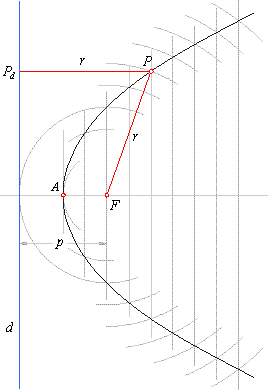 |
|
|
| Vertex form of the equation of a parabola
|
If a parabola is placed so that its vertex coincides with the origin of the coordinate system and its axis lies
along the x-axis then for every point of the parabola |

|
|
According to
definition of the parabola FP =
d(Pd P) = r
|

|
| after squaring |
 |
or |
|
| y2 =
2px |
the
vertex form of the equation of the parabola, |
|
| or |
y2 =
4ax |
if the distance between the directrix and |
|
|
focus is given by
p = 2a.
|
|
The explicit form of the equation
y = ±
Ö2px
|
|
shows that to
every positive value of x
correspond two
opposite values of y
which are symmetric relative to the
x-axis.
|
|
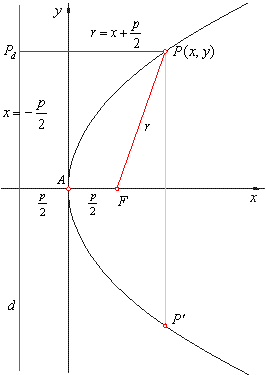 |
|
|
|
The parabola
y2 =
2px,
p >
0
|
|
is not defined for
x <
0, it opens to
the right.
|
|
For x
= p/2
the
corresponding ordinate
y = ± p.
|
|
This parabola is not a function since the vertical line
crosses
the graph more than once.
|
A focal chord is a line segment passing through the focus
with endpoints on the curve.
|
|
The latus rectum is the focal chord
(P1P2 =
2p)
perpendicular
to the axis of the parabola.
|
Therefore, we can easily sketch the graph of the parabola
using following points,
|
|
A(0,
0), P1,2(p/2,
±
p) and P3,4(2p,
±2p)
|
|
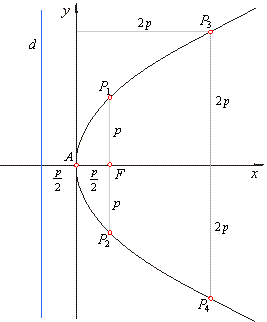 |
|
|
| Graphs
of the parabola examples |
| Example:
Write equation of the parabola
y2 = 2px
passing through the point P(-4,
4) and find the focus,
the equation of the directrix and draw its graph. |
|
|
|
Solution:
The coordinates of the point P
must satisfy the equation of the parabola
|
|
P(-4,
4)
=>
y2 =
2px
|
|
42 = 2p(-4)
=> p =
-2
|
|
thus, the
equation of the parabola y2 =
-4x.
|
|
The coordinate
of the focus,
|
|
since F(p/2,
0) then
F(-1,
0).
|
|
The equation of the directrix,
as x =
- p/2,
x =
1.
|
|
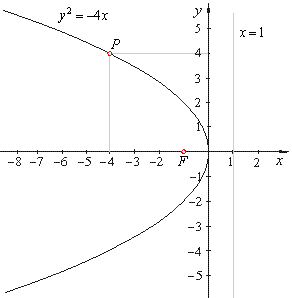 |
|
|
| Example:
Into a parabola y2 =
2px
inscribed is an equilateral triangle whose one vertex coincides with the
vertex of the parabola and whose area A =
243Ö3.
Determine equation of the parabola and remaining vertices of the triangle. |
Solution:
Let write coordinates of a point
P
of the
parabola as elements of the equilateral triangle
|

|
|
As the point P
lies on the parabola then
|

|
The area of the equilateral triangle we express by
coordinates of
P
|

|
|
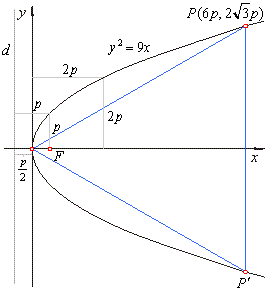 |
|
| Show
the parameter of the parabola by the side of the triangle, |
 |
|
| and
the vertices of the triangle P(6p,
2Ö3p) and
P'(6p,
-2Ö3p)
so that, P(27,
9Ö3) and
P'(27,
-9Ö3). |
| Therefore,
the equation of the parabola y2 =
2px or
y2 = 9x. |
|
| Example:
Find the vertex, the focus and the equation of the directrix and draw the graph of the parabola |
| y =
-x2
+ 6x -
7. |
|
Solution:
Rewrite
the equation of the parabola in the translatable or
general form
|
|
(x
-
x0)2 = 2p(y
-
y0) or
y
-
y0 = a(x
-
x0)2
|
|
so, y =
- x2
+ 6x -
7
=> y =
- (x2
-
6x) -
7
|
|
y =
- [(x
-
3)2
-
9] -
7
|
|
y
-
y0 = a(x
-
x0)2,
y
-
2 = -(x
-
3)2,
a
= -1.
|
|
The vertex of the parabola
A(x0, y0),
or
A(3, 2).
|
|
The focus
F(x0,
y0 + 1/(4a)),
or
F(3,
7/4).
|
|
The equation of the directrix,
|
|
y =
y0 -
1/(4a),
y = 2 +
1/4 or
y =
9/4.
|
|
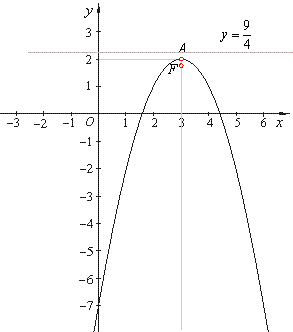 |
|
|
|
|
|
|
|
|
|
|
|
| Intermediate
algebra contents |
|
 |
|
| Copyright
© 2004 - 2020, Nabla Ltd. All rights reserved. |